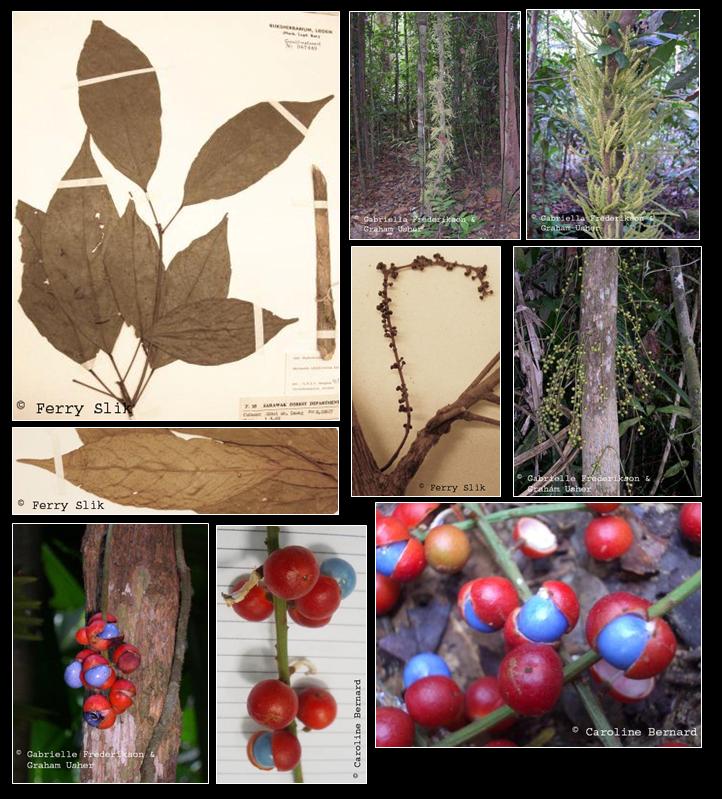Baccaurea odoratissima Elm., Leafl. Philip. Bot. 4 (1911)
Latin for 'strongly fragrant'.Note
Vegetatively almost indistinguishable from Baccaurea parviflora.
Synonyms
Baccaurea membranacea Pax & K.Hoffm.
Baccaurea trunciflora Merr.
Description
Treelet to tree 2-17 m high, dbh 4.4-20 cm, buttresses absent; branchlets sparsely hairy, female plants rarely
glabrous, Terminalia branching pattern well-developed. Indumentum of simple hairs, usually in combination with
stellate hairs. Bark yellow to grey-brown when fresh, whitish grey when dry, 0.1-2.5 mm thick; inner bark yellow
to orange-brown, 0.1-0.4 mm thick. Leaves: petiole 9-82 mm long, sparsely hairy, female plants rarely glabrous,
(green- or red-)brown when dry, raised glands present; stipules 1.7-8 by 0.5-2 mm, glabrous to sparsely hairy
outside, but densely hairy when young, glabrous inside, midrib densely hairy outside, margin (not) ciliate;
lamina obovate to elliptic (to ovate), 6.4-19 by 2-9.9 cm, l/w ratio 1.5-3.3, papery; base acute to attenuate,
apex rounded to cuspidate, up to 22 mm long; upper surface glabrous, raised glands usually present, green-brown
when dry; lower surface glabrous, sparsely hairy at veins, raised glands usually present, discoid glands absent,
brown when dry; secondary veins 3-8 per side, usually closed at margin; nervation reticulate to weakly
scalariform; young leaves red-brown. Staminate inflorescences axillary to ramiflorous, solitary to few clustered
together, 1.4-8 cm long, up to 1 mm thick, densely hairy, more than 30-flowered, flowers scattered along
inflorescence; branchlets absent; bracts 3 per branchlet, c. 0.6 mm long, persistent, glabrous to densely hairy
outside, glabrous inside, margin ciliate, sometimes hyaline. Staminate flowers 3 per branchlet, 1-2 mm diam.,
pale yellow; pedicel 0.8-2.5 mm long, upper part 0.6-2.1 mm long, densely hairy; sepals 4(-6), ovate, 0.9-1.2 by
0.7-0.9 mm, apex slightly recurved, densely hairy outside, glabrous inside; stamens 4-7, (0.2-)0.8-0.9 mm long,
glabrous; fila-ments (0.2-)0.8 mm long, straight; anthers 0.1-0.3 by c. 0.1 by 0.1 mm; disc absent; pistillode
subglobose to cylindrical, (0.2-)0.9 mm long, densely hairy, solid. Pistillate inflorescences cauline (to
ramiflorous), solitary to 3 clustered together, 2-26.5 cm long, 0.5-1.5 mm thick, sparsely to densely hairy,
9-many-flowered, red; pedicel 1.2-3.5 mm long, upper part 0.5-1 mm long, densely hairy, light green to red;
bracts 3 per flower, persistent, sparsely to densely hairy outside, glabrous inside, margin ciliate. Pistillate
flowers 5-11 mm diam.; sepals 4, obovate, 4-6 by 2-2.7 mm, sparsely hairy outside, densely hairy inside,
greenish yellow when fresh, brown outside when dry, whitish inside when dry, caducous; ovary globose, 1.2-2.5
by 1.7-2.6 mm, 2-locular, densely hairy to velutinous, light green; style 0-0.1 mm long, c. 1 mm broad; stigmas
white, 0.5-0.9 mm long, not lobed, glabrous on both sides, persistent, rarely caducous. Fruits subglobose to
double globose, 0-2-seeded, fleshy capsules, 7.2-12 by 8-13.5 by (4-)6.8-11, irregularly splitting, glabrous on
both sides, densely hairy when young outside, raised glands usually absent, red to shiny brown; pericarp up to
0.5 mm thick; column 6-10 mm long, caducous, straight; pedicel 2.5-9.5 mm long, upper part 0.5-3 mm. Seeds
subglobose to ellipsoid, laterally flattened, 6.5-10 by 2.5-8 by 2.5-6 mm; arillode blue; cotyledons 5.5-7 by
6.8-7.2 by 0.1-0.3 mm; endosperm 1.5 mm thick; radicle 1.3-1.5 mm long. [from Flora Malesiana]
Ecology
In undisturbed and disturbed mixed dipterocarp to sub-montane forests up to 1500 m
altitude. Mostly on hillsides and ridges, but also common on alluvial sites. On
sandy to clay soils.
Uses
Fruits are edible.
Distribution
Borneo, Philippines.
Local names
Borneo Botung kratek, Engkuni, Enkunig, Enkuri, Kukunal, Kunau, Kunau-kunau, Kune madamayam, Mata kunau, Mata pelanduk, Rambai tikus,
Sarotik, Tampoi keli.
